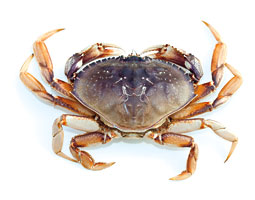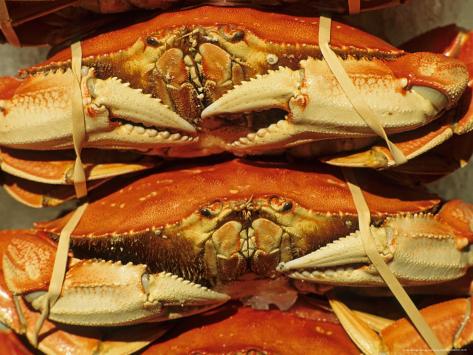天下美味 舌尖美食
天下美味 舌尖美食
今年蟹豐收 北美食蟹正當時 組圖


Dungeness crab
by Hannelore Sudermann | © Washington State University
A few weeks ago, Brian Toste ’99 and his three-man crew set out from Westport, in southwest Washington, in Toste’s 45-foot vessel Huntress in search of Dungeness crab. They spent the first few days tying line and setting out some 500 crab traps, circles of metal and wire about the size and shape of large truck tires.
A few days later, when the traps were full, they returned to their buoys and pulled them out of the water. The crew quickly empties them by hand, says Toste. They toss the females and the male crabs smaller than 6-¼ inches across the back into the water, replenish the bait (usually squid and dead fish), and drop the pot back in before zooming off to the next one.
For the first three to four weeks of the season, the trap is full with up to 20 wriggling brown crabs. Males of the right size are dropped into a live storage tank.
All this is done pretty much regardless of the weather or the waves. “You have to keep track of the tide and the times, you have to take advantage of the weather windows,” says Toste. The peak of the Dungeness crab harvest is January and February, right smack in the middle of winter storm season. Toste and his crew are often out in 30-foot swells retrieving and emptying their pots.
“It’s extremely miserable out there,” says Toste. It helps if you are aggressive and physical. “When you’re in the crab, the work’s easy.” It’s a race to tend all 500 pots in a day. Washington fishermen set pots anywhere between 12 feet and 200 feet below the surface, says Toste. He typically fishes up to 60 feet deep.
In Washington, the commercial fishing season usually opens in early December in an area 13 miles north of the Columbia River and south and a month later along the Olympic Peninsula. The tribal fishery starts earlier. While just 238 commercial fishermen are licensed along with 30 tribal fishermen to hunt for crab along Washington’s coast, there are tens of thousands of pots out there. “It’s extremely crowded,” says Toste. In some places at peak season, “we don’t have the width of a pickup between one string and another.”
“It’s like a gold rush,” says Steve Harbell, the WSU/UW Marine Fisheries coordinator. “A lot of crab is harvested in the first couple of weeks.” The season continues through the summer. But as the days grow longer, fewer and fewer crabs show up in the pots. Toste catches 85 percent of his crab in the first month, and he readies for the end of harvest somewhere in late summer after he starts pulling up empties.
While the crab is named for Dungeness Bay, an inlet along the Strait of Juan de Fuca near Port Angeles, its habitat includes the Puget Sound and the Pacific Ocean Shelf, which runs from Alaska down to Santa Barbara, California. From the intertidal shore out to 300 feet deep, the crabs cover the floor by the millions, crawling across it on their sideways hunt for food.
The commercial harvest can only open if the crabs are ready, says Brian’s dad, Ray Toste, head of the Washington Dungeness Crab Fisherman’s Association. “We do seasonal testing,” he says. Following a certain protocol, crab managers check for toxins and to see if the crab is in optimal condition, mature with strong shells and plenty of meat.
“Crustaceans are kind of like insects, they have to shed their shells to grow,” says Harbell. The crabs you find at the market or store are likely four years old and may have shed their shells 12 times to get to harvestable size. “I say to kids, ‘How would you like to grow in the same clothes you have on?’”
Before and after molting, the crab develops its new shell. While the shell is still soft, the crab inflates it slightly with water, to make it a little bigger to grow into. Before and after the molt the meat isn’t the best quality, says Harbell. “And when you handle them with a soft shell, you can kill them pretty easily.” The major molt typically takes place in the late summer and early fall. During that time, crab fishing season is closed.
Even though they’re taking around 90 percent of the harvestable crab, by throwing back the females and the smaller males, the fishermen have been able to keep the Washington Dungeness stocks high, says Harbell. “Many years ago, we thought we were on a seven year cycle with peak years every seven,” says Harbell. But the last 20 years have changed that thinking. “The record catch for Washington was about 21 million pounds, and we’ve been in about 12 million, which is a good harvest, for the past three years.”
When the crabs are mature and the shell sufficiently hard, their meat yield is about 25 percent of their weight, one of the highest yield ratios of any food crab, says Harbell. If you don’t catch your own crab, he has this advice. “First it depends on what you’re going to do with it.” Some people like to serve crab in the shell, he notes. But for just the meat, you simply need to do the math. Remember that 25 percent meat yield. “If it’s $5 for the meat, versus $20 for the whole crab, you’re paying the same price, and you don’t have to do the work.”
Nonetheless, crabs are not so hard to clean, says Harbell. “All of us amateurs can shake a crab in five minutes,” he says. It takes a pro about a minute. The task of cleaning a cooked crab involves removing the back and flipping it over and pulling off the shell covering the abdomen. Then you pull off the visceral organs. A brown matter, called crab butter, will be present. Harbell likes to eat it with the crab, but most people wash it off. Then the body can be broken in half and the legs with attached body meat can be snapped off one at a time.
Dungeness is not like blue crab, which requires an intensive picking and cleaning, says Harbell. With the Dungeness, the sweet and delicate meat slides right out.
Jim Haguewood ’81, former director of the Clallam County Economic Development Council, has been eating and cleaning crab for as long as he can remember. His family owned the Haguewoods Restaurant in Port Angeles for 58 years. After graduating in hotel and restaurant management, he came home and ran the local landmark until 1998. Since then he’s turned his efforts toward economic development, but food isn’t far behind. “When you’re helping a community develop its economy, you look at what it has that’s truly unique,” says Haguewood. “For us, one of those things is Dungeness crab. We have the name and we have the crab.”
In 2002, the Port Angeles community kicked off its first Dungeness Crab and Seafood Festival. With the seafood, a growing local wine industry, and a burgeoning year-round fresh-produce business, the town couldn’t ignore its food assets. “With the festival, restaurants create their own unique menu items and they’re paired with wine,” says Haguewood. Crab cakes, crab rolls, crab dip, crab rangoon, crab Louis, crab cocktail, crab quesadillas, and crab bisque are just some of the offerings. Still, Haguewood’s favorite way to eat Dungeness crab is the simplest—cooked in salted water and then chilled.
Locally, there are several ways to obtain crabs, he says. One is to boat out on the water and put down a crab trap. You go back at least half a day later and retrieve it. The second is to fish off a pier using a ring net with a box of bait inside. And the third requires less equipment. On certain low tides, anyone with hip waders, a sack, and a rake can walk out at night with a flashlight and spot the crabs just under the water and pick them up. “It’s quite a social event,” says Haguewood. To do any of these, you must obtain a state crab fishing license and complete a catch record card.
You can also go out and look for a commercial fisherman selling crabs off his boat, says Toste. While he sells much of his catch to a processor, Toste will also sell to the live market and to locals who seek him out at the dock.
Toste grew up with his dad and brothers out fishing. He went to WSU and studied education and later found work in the Seattle area. But eventually he found his way back to Westport and on to a fishing vessel. In 2005, he bought his own boat, and in the past few years found a great crew, the key pieces to a successful crab fishing business. “I had to come back,” says Toste. “It’s in my blood.

Dungeness Crab at Pike Place Public Market, Seattle, Washington State, USA

Dungeness Crab, Pike's Place Market, Seattle, Washington, USA
北美的肥蟹——太平洋珍寶蟹 Pacific Dungeness Crab








維基百科,自由的百科全書
生物分類
鄧金斯螃蟹
DungenessCrab.jpg

科學分類
界: 動物界 Animalia
門: 節肢動物門 Arthropoda
綱: 軟甲綱 Malacostraca
目: 十足目 Decapoda
下目: 短尾下目 Brachyura
總科: 黃道蟹總科 Cancroidea
科: 黃道蟹科 Cancridae
屬: 黃道蟹屬 Cancer
種: 首長黃道蟹 C. magister
二名法
Cancer magister
Dana, 1852
首長黃道蟹(Cancer magister),又名鄧傑內斯蟹、鄧金斯螃蟹、唐金蟹、黃金蟹或鄧津蟹[1](Dungeness Crab),是黃道蟹科黃道蟹屬的一個蟹種,通常棲息於從阿拉斯加的阿留申群島到美國加州的聖塔克魯茲(Santa Cruz)漫草叢生的海床及水底[2],可食用,是北美洲西海岸盛產的一種食用蟹[1]。
這種蟹得名於美國華盛頓州的老鎮鄧傑內斯[2],位於史魁恩以北8公裏,安吉利斯港以東25公裏。

頭部特寫
蟹殼背部呈淡紅至棕色,有些前麵有紫色斑 點,下腹為白色至淡橘色,蟹鉗為白色,最後尾節尖端呈圓形。大部分的重量為680克至1.4公斤。Cancer gracilis 大概是唯一容易和首長黃道蟹搞混的種類,兩者的螯端皆為白色。不過,首長黃道蟹的螯是明顯的鋸齒狀;C. gracilis的螯則較平滑。另外,首長黃道蟹步足的末三節有毛,C. gracilis 則無毛。
生態
在華盛頓州附近海域,鄧傑內斯蟹的直徑可達25厘米,但通常直徑小於20厘米。日常在市場上可以買得到的蟹,最小的也有兩磅重[1]。由於蟹的蟹甲寬而堅硬,鄧傑內斯蟹在第一年需更換6次蟹甲,第二年需再更換6次蟹甲才能達到性成熟。它的主要食物包括蚌類、小型甲殼類動物和小魚,但它也可以腐食為生;食物短缺時,也會出現同類相食的現象。天敵包括章魚、大型魚類、海獺和人類。在受到天敵威脅時,它可完全藏於沙中。
在交配季節,雄蟹受到雌蟹尿液中的信息素吸引而尋找雌蟹。雌雄蟹在交配前會擁抱數天。雌蟹在交配的數月以後產卵,雌蟹在交配後可攜帶 50 ~ 200萬顆卵。這些卵會附著在雌蟹的腹部三到五月,直至孵化。新生的小蟹即會遊泳。在出生後的兩年當中,小蟹要經曆約十次蛻殼才能成為成年蟹。
商業捕蟹與保育
首長黃道蟹的蟹肉質鮮美,是東北太平洋沿岸重要的商業蟹類。單是加州中部 (舊金山、蒙特利地區) 的魚場,一年平均便可捕獲200萬磅。
商業捕蟹僅限於尺寸6 ¼ 英寸 (15.9 厘米) 或更大的雄蟹。雌蟹需立即釋放。這確保螃蟹一年至少有一次繁殖季。捕蟹季通常開始於12月1日,當蟹殼已經長硬,這表示殼內已經長好結實的肌肉。在捕撈季開始前會有測試,確定螃蟹平均至少有25% 的蟹肉含量。蟹肉含量一般由13 - 30%不等,取決於脫殼及繁殖時間和環境因素,如食物和海洋條件等。此蟹全年都可在加拿大海域捕獲,尤以五月至十月為量產。
肉質細嫩、味道鮮美,帶有淡淡堅果香味,身體部位肉質滑嫩,腳肉較為紮實,主要原因是黃金蟹可以不同方向的移動,而且必要時可以相當快速。可煎、 炸、蒸、煮,或與其他海鮮混合烹調。通常以活蟹方式運送至全球各地,也有以加工及新鮮現煮或去殼蟹肉方式販售。
可持續海鮮評級機構Seafood Watch對於現時首長黃道蟹的保育給予了“最佳選擇”('Best Choice')的評價[3]。
2009年,來自俄勒岡州西北部克拉克默斯縣西林恩的日落小學學生的遊說,基於首長黃道蟹對俄勒岡州經濟的重要性,建議把首長黃道蟹訂定為“州蟹”;議案於2009年尾通過[4]。
————————————
鄧傑內斯蟹(英文名:Dungeness crab)得名於美國華盛頓州的老鎮鄧傑內斯。在華盛頓州附近海域,鄧傑內斯蟹的直徑可達25厘米,但通常直徑小於20厘米。其拉丁語學名意為“大師蟹”。
鄧傑內斯蟹得名於美國華盛頓州的老鎮鄧傑內斯。鄧傑內斯蟹通常棲息於從阿拉斯加的阿流申群島到美國加州的聖塔克魯茲鰻草叢生的水底。其拉丁語學名意為“大師蟹”。
在華盛頓州附近海域,鄧傑內斯蟹的直徑可達25厘米,但通常直徑小於20厘米。因為蟹甲寬而堅硬,鄧傑內斯蟹需更換數次蟹甲才能長大。它的主要食物包括蚌類、小型甲殼類動物和小魚,但它也可以腐食為生。在受到天敵威脅時,它可完全藏於沙中。
在交配季節,雄蟹受到雌蟹尿液中的信息素吸引而尋找雌蟹。雌雄蟹在交配前會擁抱數天。雌蟹在交配的數月以後產卵。這些卵會附著在雌蟹的腹部三到五月,直至孵化。新生的小蟹即會遊泳。在出生後的兩年當中,小蟹要經曆約十次蛻殼才能成為成年蟹。
該蟹肉質鮮美,是西北太平洋沿岸重要的商業蟹類。
學名:Cancer magister
英文名:Dungeness crab

今年蟹豐收 饕客有口福
編譯組╱綜合4日電
November 05, 2013 09:25 AM

去年在舊金山附近海域捕到的鄧金斯蟹。 (Getty Images)
灣區今年的鄧金斯蟹季已開始。
「運動捕蟹」(sport fishing)2日開始,「商業捕蟹」則於15日開始;漁民和漁業專家都估計,灣區今年會有一個很好的蟹季,收獲將會很不錯。
不過,2日第一天的運動捕蟹情況並不理想。這種捕蟹隻準每人每天捕捉十隻蟹,且每蟹至少要長至5.75吋以上,未長成的蟹不能捕。捕蟹人在2日零時零1分開始放蟹籠下海,要到第二天才提起籠子。
魯賓(Jim Rubin)在聖他克魯茲縣將籠子放在200呎的海底,原以為至少會捕到30隻蟹,但隻捕到8隻。
不過,「灣畔漁訊」的希爾(Greg Hill)說,第一天的情況不理想,並不妨礙對今年收獲的預測。
希爾說,去年漁民捕到很多細小的蟹,顯示今年的收成會不錯。
州漁獵局的科學家卡瓦斯(Pete Kalvass)也說,從曆史看,今年的收獲會很不錯。
他說,去年的鄧金斯蟹收獲達110萬磅,是1915年以來最多;2010和2011兩年的收成也很好,可以看出,目前正是鄧金斯蟹的高峰期,就算今年不比去年好,也不會大幅減少,至少會與去年差不多。
他指出,蟹產量與每年春天州漁獵局放進海裏的鄧金斯蟹幼蟲有關,從今年情況看,幼蟲的生存率很高,所以今年的收成會很不錯。
鄧金斯蟹是灣區附近海域的特產,因為這種蟹較喜歡北加州較冷的海水溫度。從金門大橋對麵的法拉農群島海域到聖荷西以南的蒙特瑞灣都是蟹產地。漁民說,今年蟹價,估計每磅為3元至3.5元。
Read more: 世界新聞網-北美華文新聞、華商資訊- 今年蟹豐收 饕客有口福




